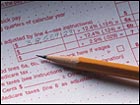|
Making sense of the refund credit
|
 |
February 7, 2002: 6:11 a.m. ET
Those who received a full refund check need not claim it on their 2001 returns.
By Gary Klott
|
CHICAGO (Tribune Media) - For the vast majority of taxpayers, the most valuable new law benefit that took effect in 2001 was the cut in most tax rates.
The Tax Relief Act of 2001 immediately lowered each of the tax rates above the 15 percent tax bracket by one-half percentage point. These rate reductions will be the simplest of the new law provisions for taxpayers to deal with on 2001 returns since the new lower rates for the top brackets are incorporated in the tax tables.
The new law also lowered from 15 percent to 10 percent the tax rate for the first $6,000 of taxable income for singles, $12,000 for couples and $10,000 for heads of household. But you won't find the 10 percent rate included in the 2001 tax tables. That's because the benefit of the 10 percent rate was delivered to most taxpayers through the tax rebate checks that the IRS sent out last summer and fall.
Congress wanted to quickly put money into the pockets of Americans in order to stimulate the sagging economy. So lawmakers decided to provide the benefit of the new 10 percent rate through the "advance payment" rebate checks, instead of on 2001 returns. (If you do the math, you'll find the maximum rebate amount -- $300 for singles, $600 for married couples, $500 for heads of household -- is the same as the maximum tax savings from the new 10 percent rate.)
If you received the maximum rebate, there is nothing you need to do on your federal income tax return to account for the rebate. None of it needs to be reported. But if you were among the millions who didn't get a rebate check or received a check for less than the maximum amount, you may be eligible to claim a special "rate reduction credit" on your tax return to reflect the benefit of the new 10 percent rate. The credit is figured on a nine-line worksheet inside IRS instruction booklets.
Among those likely to be eligible for the credit are lower-income workers who earned more in 2001 than they did in 2000. The IRS figured the size of rebate checks using information reported on 2000 income tax returns. But the rate reduction credit will be based on your 2001 income. Also likely candidates for an equivalent benefit are dependents, including high school and college students who had part-time jobs and children with investment income. Dependents weren't eligible for last year's tax rebates. And they aren't eligible for the rate reduction credit.
But dependents can fill out a special three-line worksheet inside IRS instruction booklets to get the benefit of the 10 percent rate for 2001.
Early confusion
The rate reduction credit and dependent benefit are likely to be major sources of taxpayer confusion and errors this filing season. The IRS said many early filers mistakenly listed the amount of their tax rebates on the line for the rate reduction credit, when they should have left the line blank. And many people who are eligible for the rate reduction credit left the line blank, when they should have inserted an amount from the rate reduction credit worksheet.
Figuring the benefit
The rate reduction credit and the dependent benefit are figured similar to the way that the IRS figured the tax rebate checks. As a general rule, the benefit will be equal to 5 percent of the first $6,000 in "taxable income" for singles, $12,000 for couples, and $10,000 for heads of household. (Taxable income is the amount after deductions and personal exemptions.)
So the most anyone can receive from the rate reduction credit or the dependent worksheet is $300 for singles, $600 for couples or $500 for heads of household. But most people will get less. One reason would be if your taxable income is less than the $6,000-to-$12,000 threshold amounts. For instance, a single person with $3,000 in taxable income would get a benefit of no more $150 (5 percent of $3,000).
Click here for CNN/Money's tax center
A single person would need to have at least $6,000 in taxable income to get the maximum $300 benefit. Even if your taxable income is that high, you may end up with less than the maximum benefit because the rate reduction credit can't exceed the amount of your tax liability after subtracting certain tax credits, including the dependent care credit and the Hope and Lifetime college tuition credits. The rate reduction credit also has to be reduced by the amount of any tax rebate you received last year.
So a single person with taxable income of at least $6,000 in 2001 would generally be eligible for the maximum $300 benefit. But if he received a $200 rebate last year, he would be eligible for only a $100 rate reduction credit on his 2001 return.
If you received more of a rebate last year than you would be due based on your 2001 income, enjoy your windfall. You don't have to repay the difference or report it on your tax return. 
|
|
|
|
|
|

|

